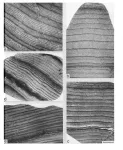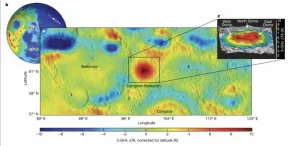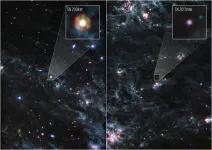(Press-News.org)
Billions of years ago, in the giant disk of dust, gas, and rocky material that orbited our young sun, larger and larger bodies coalesced to eventually give rise to the planets, moons, and asteroids we see today. Scientists are still trying to understand the processes by which planets, including our home planet, were formed. One way researchers can study how Earth formed is to examine the magmas that flow up from deep within the planet’s interior. The chemical signatures from these samples contain a record of the timing and the nature of the materials that came together to form Earth—analogous to how fossils give us clues about Earth's biological past.
Now, a study from Caltech shows that the early Earth accreted from hot and dry materials, indicating that our planet's water—the crucial component for the evolution of life—must have arrived late in the history of Earth's formation.
The study, involving an international team of researchers, was conducted in the laboratories of Francois Tissot, assistant professor of geochemistry and Heritage Medical Research Institute Investigator; and Yigang Zhang of the University of Chinese Academy of Sciences. A paper describing the research appears in the journal Science Advances. Caltech graduate student Weiyi Liu is the paper's first author.
Though humans do not have a way to journey into the interior of our planet, the rocks deep within the earth can naturally make their way to the surface in the form of lavas. The parental magmas of these lavas can originate from different depths within Earth, such as the upper mantle, which begins around 15 kilometers under the surface and extends for about 680 kilometers; or the lower mantle, which spans from a depth of 680 kilometers all the way to the core–mantle boundary at about 2,900 kilometers below our feet. Like sampling different layers of a cake—the frosting, the filling, the sponge—scientists can study magmas originating from different depths to understand the different "flavors" of Earth’s layers: the chemicals found within and their ratios with respect to one another.
Because the formation of Earth was not instantaneous and instead involved materials accreting over time, samples from the lower mantle and upper mantle give different clues to what was happening over time during Earth's accretion. In the new study, the team found that the early Earth was primarily composed of dry, rocky materials: chemical signatures from deep within the planet showed a lack of so-called volatiles, which are easily evaporated materials like water and iodine. In contrast, samples of the upper mantle revealed a higher proportion of volatiles, three times of those found in the lower mantle. Based on these chemical ratios, Liu created a model that showed Earth formed from hot, dry, rocky materials, and that a major addition of life-essential volatiles, including water, only occurred during the last 15 percent (or less) of Earth's formation.
The study is a crucial contribution to theories of planet formation, a field which has undergone several paradigm shifts in recent decades and is still characterized by vigorous scientific debate. In this context, the new study makes important predictions for the nature of the building blocks of other terrestrial planets—Mercury and Venus—which would be expected to have formed from similarly dry materials.
"Space exploration to the outer planets is really important because a water world is probably the best place to look for extraterrestrial life," Tissot says. "But the inner solar system shouldn't be forgotten. There hasn't been a mission that's touched Venus’s surface for nearly 40 years, and there has never been a mission to the surface of Mercury. We need to be able to study those worlds to better understand how terrestrial planets such as Earth formed."
The paper is titled "I/Pu reveals Earth mainly accreted from volatile-poor differentiated planetesimals." In addition to Liu and Tissot, co-authors are Zhang of the University of Chinese Academy of Sciences; Guillaume Avice of the Université Paris Cité, Institut de physique du globe de Paris; Zhilin Ye of the Chinese Academy of Sciences; and Qing-Zhu Yin of the University of California, Davis. Funding was provided by the Chinese Academy of Sciences, the National Science Foundation, a Packard Fellowship for Science and Engineering, the Heritage Medical Research Institute, and Caltech.
END
University of Queensland researchers have optimised a new technique to help forecast how volcanoes will behave, which could save lives and property around the world.
Dr Teresa Ubide from UQ’s School of the Environment and a team of international collaborators have trialled a new application of the tongue-twisting approach: laser ablation inductively coupled plasma quadruple mass spectrometry.
“It’s a mouthful, but this high-resolution technique offers clearer data on what’s chemically occurring within a volcano’s magma, which is fundamental to forecasting eruption patterns and changes,” Dr Ubide said.
She described magma ...
New device shows promise in small animal studies
Not only can it restore normal heart rhythms, it also can show which areas of the heart are functioning well and which areas are not
After the device is no longer needed, it harmlessly dissolves inside the body, bypassing the need for extraction
EVANSTON, Ill. — Nearly 700,000 people in the United States die from heart disease every year, and one-third of those deaths result from complications in the first weeks or months following a traumatic heart-related event.
To help prevent those deaths, researchers at Northwestern ...
A team of astrophysicists at the University of Toronto (U of T) has revealed how the slow and steady lengthening of Earth’s day caused by the tidal pull of the moon was halted for over a billion years.
They show that from approximately two billion years ago until 600 million years ago, an atmospheric tide driven by the sun countered the effect of the moon, keeping Earth’s rotational rate steady and the length of day at a constant 19.5 hours.
Without this billion-year pause in the slowing of our planet’s rotation, our current 24-hour day would stretch to over 60 hours.
The ...
Article URL: https://journals.plos.org/plosone/article?id=10.1371/journal.pone.0287112
Article Title: Contributions of neighborhood social environment and air pollution exposure to Black-White disparities in epigenetic aging
Author Countries: USA
Funding: This work was supported by National Institute on Aging: R01-AG066152 (CM), R01- AG070885 (RB), P30-AG072979 (CM). Additional support includes Pennsylvania Department of Health (2019NF4100087335; CM), and Penn Institute on Aging (CM). National Institute on Aging: https://www.nia.nih.gov Pennsylvania Department of Health: https://www.health.pa.gov/Pages/default.aspx Penn Institute on Aging: https://www.med.upenn.edu/aging/. ...
New research from the Institute of Psychiatry, Psychology & Neuroscience (IoPPN) at King’s College London and City University New York, published today (Wednesday 5 July) in JAMA Psychiatry, has found that the way childhood abuse and/or neglect is remembered and processed has a greater impact on later mental health than the experience itself. The authors suggest that, even in the absence of documented evidence, clinicians can use patients’ self-reported experiences of abuse and neglect to identify those at risk of developing mental health difficulties ...
DALLAS (SMU) – A large formation of granite discovered below the lunar surface likely was formed from the cooling of molten lava that fed a volcano or volcanoes that erupted early in the Moon’s history – as long as 3.5 billion years ago.
A team of scientists led by Matthew Siegler, an SMU research professor and research scientist with the Planetary Science Institute, has published a study in Nature that used microwave frequency data to measure heat below the surface of a suspected volcanic ...
We interact with bits and bytes everyday – whether that’s through sending a text message or receiving an email.
There’s also quantum bits, or qubits, that have critical differences from common bits and bytes. These photons – particles of light – can carry quantum information and offer exceptional capabilities that can’t be achieved any other way. Unlike binary computing, where bits can only represent a 0 or 1, qubit behavior exists in the realm of quantum mechanics. Through “superpositioning,” a qubit can represent a 0, ...
Researchers using NASA’s James Webb Space Telescope have made major strides in confirming the source of dust in early galaxies. Observations of two Type II supernovae, Supernova 2004et (SN 2004et) and Supernova 2017eaw (SN 2017eaw), have revealed large amounts of dust within the ejecta of each of these objects. The mass found by researchers supports the theory that supernovae played a key role in supplying dust to the early universe.
Dust is a building block for many things in our universe – planets in particular. As dust from dying stars spreads through space, it carries essential elements to help give birth to the next generation of stars ...
Danish researchers solve the mystery of how deadly virus hide in humans
With a new method for examining virus samples researchers from the University of Copenhagen have solved an old riddle about how Hepatitis C virus avoids the human body's immune defenses. The result may have an impact on how we track and treat viral diseases in general.
An estimated 50 million people worldwide are infected with with chronic hepatitis C. The hepatitis C virus can cause inflammation and scarring of the liver, and in the worst case, liver cancer. Hepatitis C was discovered in 1989 and is one of the most studied viruses on the planet. Yet for decades, how it manages to evade the human immune ...
A study of the genetic variation that makes mice more susceptible to bowel inflammation after a high-fat diet has identified candidate genes which may drive inflammatory bowel disease (IBD) in humans. The findings are published as a Reviewed Preprint in eLife.
Described by the editors as a fundamental study, the work provides a framework for using systems genetics approaches to dissect the complex mechanisms of gut physiology. The authors show how it is possible to use genetically diverse but well-characterised mice to interrogate intestinal inflammation and pinpoint genes influenced by the environment ...





